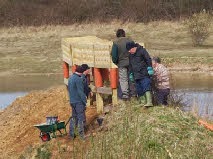- Watton Nature Reserve has never been owned or run by Yorkshire Water - in spite of its proximity for which many have attributed it so.
- If you want to view the site please do so responsibly with due regard to wildlife, observers and local land owners. Contrary to details the site is best viewed by parking at Wilfholme Landing and walking north along the public footpath on the west bank of Beverley and Barmston Drain and viewing from the public hide (we've had folk wandering around the reserve and leaving gates with neighbouring stock open).
- We've heard various interesting interpretations of a nature reserve by prospective purchasers so read on to learn more of the site and its inhabitants.
Watton Nature Reserve was formerly part of the neighbouring Easingwold Farm until it was purchased in around 1990 by the then National Rivers Authority to provide aggregates for the river Hull Flood defences. Previous to this it was known as Easingwold Plantation and reportedly the last breeding site for red-backed shrike in Yorkshire - alas all signs long gone. The site does flood on a regular basis - this being last winter:
And this the current EA access track:
The site was declared a Nature Reserve which continued under the newly created Environment Agency and much work has been done in partnership with Hull Valley Wildlife Group, Yorkshire Wildlife Trust and Tophill Low Volunteers over the last 22 years including the demolition of the former hide ready for the new Gilleard Bros hide:


And the installation of tern rafts:
In addition to a large amount of work on habitat management with the kind help of local farmers co-ordinated by volunteers and water level management. This work has attracted a number of breeding species like common terns Tony McLean:
Little ringed plover (schedule one protected under the Wildlife and Countryside act 1981) Erich Hediger:
Barn owl (schedule one protected at all times) Tony McLean:
Kingfishers close by (again schedule one at all times) Tony McLean:
With European Protected Species and Schedule 5 otter (Protected at all times including disturbance or damage to a place used for shelter or protection (TM)
With water vole and great crested newt (same protection).
The site too has hosted a number of rarities in its time notably stone curlew, white stork, temminck's stint, avocets and often holds wintering bittern and a roost of little egrets:
The site's signature species is the small number of smew which overwinter annually making it one of the north of England's most reliable locations for the bird of which only 112 overwintered in the UK in recent WeBS publications:
The area has been monitored for the last 10 years as part of the British Trust for Ornithology's Wetland Bird Survey by volunteers and as such has is pending designation as a Local Wildlife Site by East Riding Council which carries various planning implications.
The site is overlooked by a Yorkshire Water hide with around 10,000 visits per annum. We note that the sales agreement states that shooting and fishing rights are to be retained which is reassuring for its conservation.
The sale of the reserve is on behalf of the Environment Agency as part of a wider sell off of surplus assets (So please direct any enquiries there or with the selling agents)
As the site is on the open market it is unclear who the eventual recipient will be. As has been suggested in the brochure the site does have development potential - in my personal opinion for selective thinning of the shelterbelt, well timed constructive grazing management and upkeep of viewing facilities for the variety of wildlife it hosts (if you need any inspiration simply look at Tony McLean's site here).
For other uses please consider that it is an overlooked public site so unsympathetic management with respect to its protected species, designations and restrictions would be unlikely missed. That said many will be glad to assist a new owner keen to build on the success of a very special place for East Yorkshire's wildlife as part of the river Hull corridor of excellent wetland habitats.

















